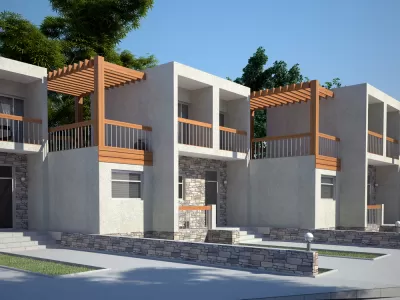A recent article explains how, and why, small lot subdivisions get built in Los Angeles. Also, the city has recently updated a procedural glitch to make permitting easier for small lot projects.

Will Macht examines the growing practice of small lot development, by first explaining its popularity with developers: "The Great Recession halted the building boom, leaving many developers and architects averse to large-scale projects with greater financial risk and exposure to long-term construction liability. In response to these factors, as well as changing market preferences, some developers are now experimenting with small- and intermediate-scale projects to increase density in a shorter time frame and at lower risk."
Designers love the small lot typology as well: "At the same time, most architecture firms no longer design single-family houses except for very wealthy clients. Some firms are experimenting with designing single-family homes at intermediate densities that enable them to spread their fees over more projects than when they work on one-off, high-design, custom-built houses."
The article continues into great detail about a case study of small lot development in Los Angeles, and to make the case for the flexibility offered by "fee-simple" lots.
On a related note, the Los Angeles Department of City Planning announced an improvement to the permitting process for small lot projects. Here's how an emailed statement explains the update, with will take effect on September 16, 2014:
"Previously, a glitch in City regulations required developers with approved plans to either wait upwards of two years for final maps to record or file for code deviations in order to receive building permits. This inefficiency cost developers and the Planning Department valuable time and left neighborhoods with delayed projects and confusing project descriptions."
"The [approved] code amendment will immediately relieve 59 code-compliant projects of the need to file for deviations or wait lengthy periods of time before beginning construction. Simultaneously, the Department will have more time to focus on the project, rather than processing additional requests."
FULL STORY: Fee-Simple Small Lots Yield Urbane Density

Planetizen Federal Action Tracker
A weekly monitor of how Trump’s orders and actions are impacting planners and planning in America.

Restaurant Patios Were a Pandemic Win — Why Were They so Hard to Keep?
Social distancing requirements and changes in travel patterns prompted cities to pilot new uses for street and sidewalk space. Then it got complicated.

Map: Where Senate Republicans Want to Sell Your Public Lands
For public land advocates, the Senate Republicans’ proposal to sell millions of acres of public land in the West is “the biggest fight of their careers.”

Maui's Vacation Rental Debate Turns Ugly
Verbal attacks, misinformation campaigns and fistfights plague a high-stakes debate to convert thousands of vacation rentals into long-term housing.

San Francisco Suspends Traffic Calming Amidst Record Deaths
Citing “a challenging fiscal landscape,” the city will cease the program on the heels of 42 traffic deaths, including 24 pedestrians.

California Homeless Arrests, Citations Spike After Ruling
An investigation reveals that anti-homeless actions increased up to 500% after Grants Pass v. Johnson — even in cities claiming no policy change.
Urban Design for Planners 1: Software Tools
This six-course series explores essential urban design concepts using open source software and equips planners with the tools they need to participate fully in the urban design process.
Planning for Universal Design
Learn the tools for implementing Universal Design in planning regulations.
Heyer Gruel & Associates PA
JM Goldson LLC
Custer County Colorado
City of Camden Redevelopment Agency
City of Astoria
Transportation Research & Education Center (TREC) at Portland State University
Camden Redevelopment Agency
City of Claremont
Municipality of Princeton (NJ)




























